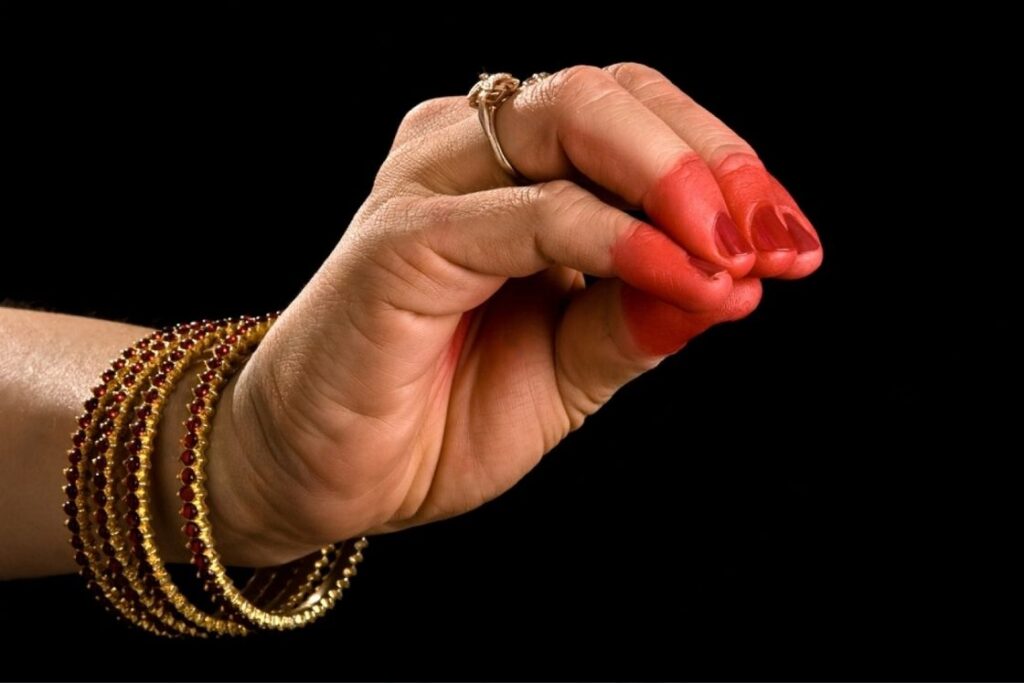
Mukula Mudra, also referred to as the “Beak Hand Gesture,” is a therapeutic hand mudra commonly used in yoga and Ayurveda. This mudra is deeply connected to Ayurvedic principles, specifically the balance of doshas – Vata, Pitta and Kapha.
Mukula Mudra is performed by bringing the thumb and fingers together to form a beak-like shape, symbolizing its name. Its practice facilitates the alignment and harmonization of these doshas, fostering overall well-being.
The three doshas; Vata, Pitta and Kapha are essential components of Ayurveda, influencing health and vitality. When these doshas are imbalanced, it can result in various physical and mental issues. Mukula Mudra, with its unique hand gesture, aims to restore balance among these doshas by directing the body’s energy flow.
Meaning
Mukula Mudra derives its name from Sanskrit word “Mukula” translates to “bud,” and “Mudra” signifies “gesture” or “seal.” Therefore, the meaning of Mukula Mudra can be understood as the “Bud Gesture” or the “Gesture of a Bud.”
In this mudra, the fingers of the hand are joined together at tips to create a beak-like shape, reminiscent of the bud of a flower or a bird’s beak. The symbolism of a bud in Mukula Mudra signifies the potential for growth, awakening, and transformation. It embodies the concept of something closed or hidden, much like a bud, holding the promise of blossoming into its full potential.
Mukula Meanings in the Viniyoga Shloka
कुमुदे भोजने पञ्चबाणे मुद्रादिधरणे नाभौ च कदलिपुष्पे युज्यते मुकुलः करः ||
Kumude bhujane panchabane mudradidharane Nabhau cha kadalipushpe yujyate mukulah karah
- Kumude: Referring to a lily flower, this interpretation aligns with the idea of Mukula representing the bud or blossoming of a flower, signifying growth and awakening.
- Bhojane: This term suggests “eating.” While it might not be immediately evident how it relates to Mukula Mudra, it could symbolize the nurturing and sustenance of one’s inner growth, akin to the nourishment of a bud into a flower.
- Panchabane: The reference to “Five arrows” in the context of Manmada (cupid) could symbolize the idea of love and attraction, perhaps implying that Mukula Mudra has significance in relationships and emotional well-being.
- Mudradidharane: “Holding the Signet” could signify the importance of Mukula Mudra as a symbolic seal or gesture in various practices, such as yoga and meditation.
- Nabhao: Mentioning “Navel” could imply that Mukula Mudra has a connection to the energy center around the navel region, which is significant in various spiritual and energetic traditions.
- Kadalipushpe: The “Plantain Flower” might relate to the idea of blossoming and growth, similar to a bud, emphasizing Mukula Mudra’s role in personal transformation and awakening.
Synonyms and variations
Mukula Mudra is known by different names in various traditions and contexts. It’s essential to recognize these synonyms to understand its wide-ranging applications.
Samana mudra

In certain practices, Mukula Mudra goes by the name Samana Mudra.
Performing Samana Mudra is also believed to balance the digestive system. Samana Mudra, which resembles a bud and is sometimes referred to as Mukula Mudra (where “mukula” is Sanskrit for “bud”), holds a significant place in yogic practices.
This mudra aligns with the concept of Samana Vayu, one of the five vital life forces or prana vayus in yoga. Samana Vayu plays a pivotal role in the digestion and nourishment of the body, making this mudra an essential element in promoting healthy digestion and overall well-being.
Shukri mudra
Shukri Mudra is another name attributed to Mukula Mudra, revealing its presence and importance in distinct cultural and traditional settings.
Tridosha Naashak Mudra
Mukula Mudra is also recognized as Tridosha Naashak Mudra in some contexts, as it is believed to contribute to the balance of the three Doshas: Kapha, Vata, and Pitta, within the body.
Beak Hand Mudra
With its most common designation as the Beak Hand Mudra, the gesture’s resemblance to a bird’s beak is evident and serves as a reference point for practitioners and enthusiasts.
Exploring these synonyms sheds light on the diverse interpretations and applications of Mukula Mudra, enriching its cultural and spiritual significance.
How to practice mukula mudra?
Mukula Mudra can be practiced in any comfortable posture, including sitting, standing, or lying down. However, for optimal results and enhanced concentration, it is advisable to practice it in a comfortable meditative posture.

- Begin by sitting in a comfortable meditative posture, such as Padmasana or Swastikasana.
- Direct your full awareness to your breath as you sit in this position.
- Place your hands on your knees with your palms facing upward towards the sky.
- In both hands, join all your fingers and connect your thumb-tips with them, ensuring that your thumbs touch the fingertips of all the fingers.
- Keep the remaining fingers comfortably bent, and be gentle with yourself throughout the practice.
- You can position your hands so that your left hand is slightly above the navel, and the right hand is below it. They should be covering each other with their palms without touching, creating a sense of the left hand pouring energy into the right.
- Slowly and comfortably close your eyes.
- Focus your awareness on your breath and take deep breaths.
- If you feel at ease, you can enhance your practice by incorporating chanting of the “Om” mantra for deeper concentration, or you can explore various Pranayamas (breath control techniques) and meditations alongside Mukula Mudra.
Precautions for mukula mudra
- Ensure physical comfort in your sitting or meditative posture.
- Create the hand gesture with gentleness, avoiding force or strain.
- Maintain focus on breath and the mudra while avoiding distractions.
- Breathe naturally and deeply, without forcing your breath.
- If closing your eyes, do so slowly and gently to remain aware of your surroundings.
- When incorporating mantra chanting, be familiar with the specific mantra and its pronunciation, chanting with reverence and concentration.
Time & duration
The duration for performing Mukula Mudra can vary depending on individual preferences and needs. There are no strict rules regarding the duration of this mudra, but generally, it can be practiced for about 15 to 30 minutes per session.
Here are some considerations:
- Short Sessions: If you are new to Mukula Mudra or meditation in general, you can start with shorter sessions, around 10 or 15 minutes. This allows you to get accustomed to the practice without feeling overwhelmed.
- Intermediate Sessions: For those with some experience, you can extend the practice to 30 minutes. This duration provides ample time to concentrate and experience the benefits of the mudra.
- Longer Sessions: Some advanced practitioners may choose to perform Mukula Mudra for longer durations, even up to an hour. However, it’s essential to listen to your body and mind during extended sessions and ensure you are comfortable throughout.
- Consistency: The key to reaping the full benefits of Mukula Mudra is regular practice. It’s often more beneficial to practice for a shorter duration consistently than occasionally doing longer sessions.
Affirmation
Incorporating the affirmation, “I am healing myself, and I am getting healed,” during Mukula Mudra practice enhances its effectiveness. This affirmation aligns with the mudra’s primary intention of channeling healing energy within, reinforcing your body’s innate ability to heal and harmonize.
It acts as a guiding beacon, steering your focus towards the self-healing process and reinforces the idea that your body, mind, and spirit possess the inherent power to mend, restore balance, and cultivate well-being.
Mukula mudra benefits

1. Balancing the Doshas
Mukula Mudra is said to help balance the Vata, Pitta, and Kapha doshas. It directs energy to points in the body where healing is needed, which can contribute to dosha equilibrium. For example, if a particular dosha is aggravated, this mudra may aid in reducing its dominance.
2. Manipura Chakra Activation
Mukula mudra stimulates the Manipura Chakra, located in the abdominal area. The Manipura Chakra is associated with the Samana Vayu, which governs digestion and assimilation. By energizing this chakra, Mukula Mudra indirectly influences the Samana Vayu and supports efficient digestion and energy absorption.
3. Digestive Health
Mukula Mudra enhances digestive health by stimulating digestive organs for efficient food breakdown. It aids those with digestive issues like bloating, gas, or constipation. “Samana Vayu,” associated with digestion, plays a vital role in food and energy processing within the body.
4. Promotes Grounding
Mukula Mudra has the remarkable ability to make individuals feel more grounded. In a world filled with constant motion and distractions, this grounding effect provides stability and a sense of being centered.
5. Stress Reduction
Mukula Mudra can play a role in reducing stress and anxiety. By channeling energy and promoting a sense of balance, it helps calm the mind and relax the body. This, in turn, leads to reduced stress levels, mental clarity, and emotional equilibrium, allowing individuals to better manage the challenges of daily life.
6. Concentration Enhancement
Mukula Mudra enhances meditation by deepening concentration, promoting inner peace and self-awareness. It’s a valuable tool for improving meditation experiences and connecting with one’s inner self more profoundly.
Conclusion
Mukula Mudra is a powerful mudra to three balance doshas, activate the Manipura Chakra, ground individuals, and direct healing energy is a testament to its significance. While it may seem like a simple hand gesture, its potential for inner strength and vitality is boundless.




